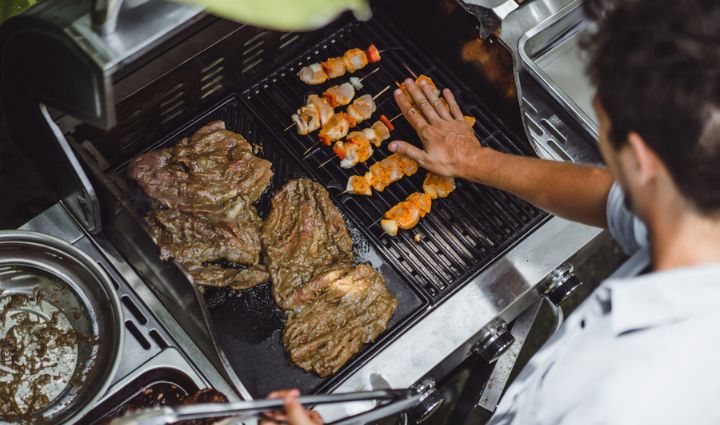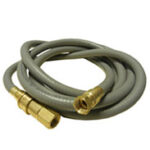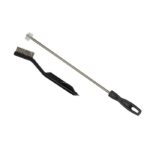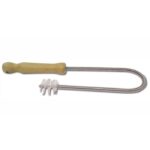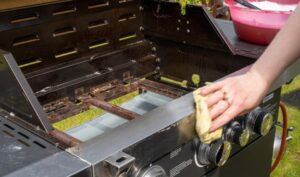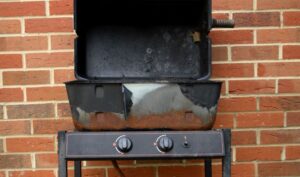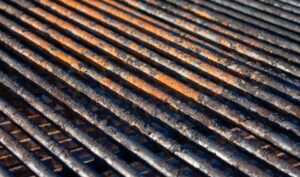The Complete Guide to Troubleshooting Gas Grill Issues is your source for step-by-step instructions on how to diagnose and fix the most common gas grill issues. Whether your grill isn’t heating properly, won’t stay lit, or simply has rusty parts, we’ve got the answers you need to get your gas barbecue firing on all cylinders.
Nothing takes the joy out of a cookout faster than discovering that your natural gas grill is not getting gas.
If natural gas isn’t flowing to your grill, your grill may not turn on at all, it may not get hot enough, or you may experience a low flame. All of these issues can halt your cookout plans, but unlike with propane grilling, you can’t simply change out your gas tank for a fresh one to get the fire going.
With a natural gas grill, reduced or no natural gas flow to your grill could be caused by one of several problems:
- The gas line is turned off
- There’s a gas leak
- The gas line has been damaged
- The igniter isn’t working
- The barbecue is in bypass mode
- There’s a blockage or burner misalignment
In this section of the Complete Guide to Troubleshooting Gas Grill Issues, we’ll explore six of the most common reasons why your natural gas grill is not getting hot enough, not getting gas, or is struggling with a low flame, and how to fix them.
Let’s get cooking.
6 Reasons Your Natural Gas Grill is Not Getting Gas
1. The gas line is turned off
If it’s your first cookout of the season, you went away on vacation, or there is any other conceivable reason that you or someone else in your home may have turned off the natural gas line to your grill—or honestly, even if there isn’t—check to make sure the gas line to the natural gas grill isn’t turned off.
Consider this fix the grilling equivalent of “unplug it and plug it back in” if you’re looking to troubleshoot a natural gas grill with low flame or other gas issues. It may sound basic, but it’s always the best place to start.
2. There’s a gas leak
If natural gas still isn’t flowing to your grill, you may have a gas leak. Gas leaks can be caused by something as simple as a loose connection or a damaged gas hose. To check your grill for gas leaks, follow these easy steps:
- Mix a 50/50 solution of soap and water.
- Brush the solution onto your gas hose and any connection points.
- Open your gas supply. If there are leaks, you will see bubbles forming at the source of the leak.
- Close the gas supply.
If you see bubbles, try to determine where they are coming from:
- If you see bubbles coming from a connection point, disconnect and reconnect your hose. Run the test again. If you still see bubbles, tighten the gas hose and regulator.
- If they are coming from the hose, replace the hose.
Shop replacement hoses:
3. The gas line has been damaged
If your gas is on but your natural gas grill is not getting hot enough, has a low flame, or is still not getting gas at all, the gas line may have been damaged, either at the quick connect point or at the line in the ground. Inspect the quick connect point and the gas lines for any visible damage and to ensure the grill is connected properly.
If you or someone else has been digging in your yard and you suspect you have hit your gas line, you should turn off the gas and contact your gas company to have someone come out and inspect the lines.
4. The igniter isn’t working
If you aren’t hearing a clicking or hard snapping sound when you try to start your grill, that’s a sign that your natural gas grill’s igniter is not working. This could mean that the batteries are dead, the electrodes are dirty, or the igniter itself needs replacing. Thankfully, all of these issues can be fixed easily. Learn how to repair or replace your igniter.
5. Your barbecue is in bypass mode
If the igniter is working but your natural gas grill is still not getting gas or reaching high temperatures, your barbecue may be in bypass mode.
All gas grill regulators are equipped with a safety device called an “Overfill Protection Device” (OPD), including natural gas grills. This flow-limiting device automatically triggers when it detects a gas leak (or what it perceives to be a gas leak), reducing the gas flow to 10% or less than its standard volume. This prevents the grill from becoming dangerously overfilled with gas.
GRILL SPOT TIP: Bypass mode can be triggered by mistake from something as simple as turning on the control knobs before you turn on the natural gas valve.
If your natural gas grill has a low flame, isn’t hot enough, or isn’t lighting at all, these could be signs that your grill is in bypass mode. The first thing to do is perform a gas leak test (see next section), since that’s the problem this safety device is designed to take care of.
If there are no gas leaks, your next step is to reset the gas grill regulator. Resetting the gas grill regulator OPD is simple. Follow these steps:
- Open the grill lid.
- Turn off the gas to the grill.
- Turn all the control knobs up to high, including any side burners.
- Wait for one full minute, then turn the control knobs off.
- Slowly turn the gas back on.
- Light your grill as normal.
6. There’s a blockage or burner misalignment
If there is any food debris clogging up the burners or the burners have been knocked out of alignment, this can prevent a natural gas grill from getting enough gas to light or reach hot enough temperatures for cooking. Check your burners for misalignment and obstruction—the burner tube should be properly seated on the gas valve, with the valve sitting inside the opening of the burner.
If there are no problems with alignment, clean the venturi tubes and burner portholes to get rid of any debris that could be limiting gas flow:
- Remove the burners and use a bottle brush or special venturi brush to clean out the venturi tube of each burner.
- Use a wire brush or other needle-like object to remove any deposits from each clogged port and restore normal gas flow.
Conclusion
There could be a few different reasons why your natural gas grill is not getting gas, has a low flame, or is not hot enough. Thankfully, all of the reasons have very easy fixes you can handle at home by:
- Turning on the gas line
- Repairing a gas leak
- Repairing or reconnecting the gas line
- Replacing your igniter
- Getting your grill out of bypass mode
- Cleaning out a burner blockage or misalignment
Still having trouble getting your grill up to temp? Keep reading: Why Is My BBQ Not Getting Hot Enough? How To Diagnose and Fix Gas Grill Temperature Problems
Learn more about different grill problems, what causes them, and how to solve them in our Complete Guide to Troubleshooting Gas Grill Issues:

